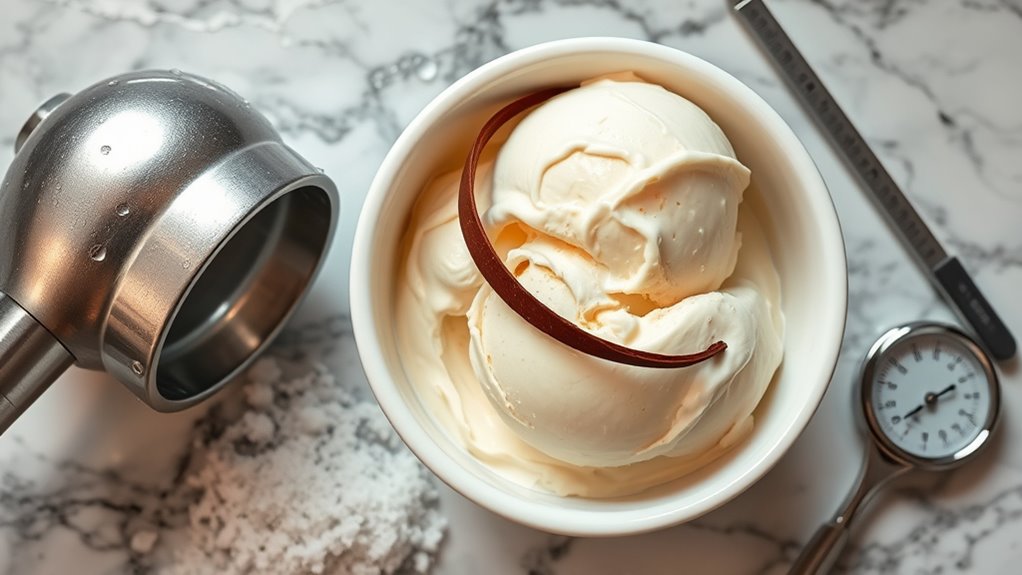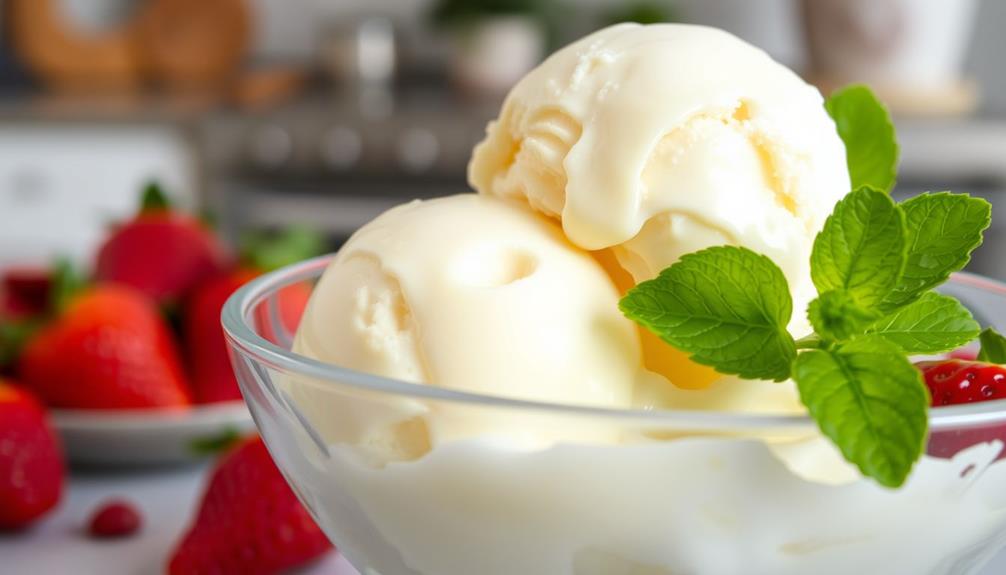Churning and temperature control are key to making smooth, creamy ice cream. When you churn, you’re breaking down ice crystals and incorporating air, giving your ice cream a light texture. Keeping temperatures low during freezing promotes smaller ice crystals, which results in a silky mouthfeel. Plus, stabilizers help maintain consistency. Understanding these principles can elevate your ice cream-making skills. If you’re curious about more techniques for the perfect scoop, there’s plenty more to explore.
Key Takeaways
- Churning incorporates air into the ice cream, enhancing texture and making it lighter and fluffier.
- Proper temperature control during freezing promotes the formation of small ice crystals, resulting in a smooth mouthfeel.
- Fast freezing rates increase nucleation points, preventing the formation of larger, grainy ice crystals.
- Dynamic freezing techniques, like using scraped-surface freezers, improve texture by mixing and agitating the ice cream base effectively.
- Maintaining a freezing range of -3°C to -6°C ensures optimal consistency and prevents recrystallization during storage.
Understanding Ice Cream Composition

When you plunge into ice cream composition, you’ll discover a fascinating blend of ingredients that create its beloved texture and flavor.
The foundation starts with milkfat, typically ranging from 10% to 16%, which gives ice cream its rich creaminess. Solar energy solutions can also be leveraged to power ice cream production facilities, emphasizing sustainability in the food industry. The creamy texture is further enhanced by churning perfection during the freezing process. Ice cream is a popular treat among all age groups, highlighting its universal appeal.
Milk solids-not-fat contribute essential proteins and carbohydrates, making up 9% to 12%.
Sweeteners, like sucrose and corn syrup, account for 12% to 16%, not only adding sweetness but also lowering the freezing point for a softer treat.
Water, the most abundant component, comprises 55% to 64%.
Stabilizers and emulsifiers, present in small amounts, help maintain a smooth texture by preventing ice crystal growth. Emulsifiers like DMG improve smoothness, thickness, and mouthfeel while controlling air distribution.
Together, these elements create the delightful experience you love in every scoop.
The Importance of Ice Crystal Size
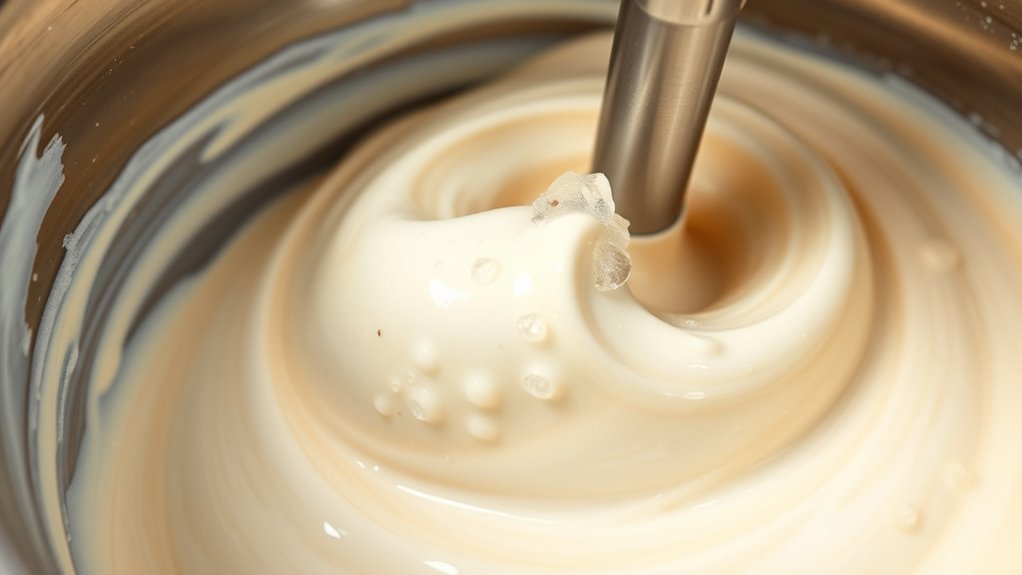
Understanding the composition of ice cream sets the stage for appreciating the role of ice crystal size in its texture.
Small ice crystals, measuring between 10 to 20 µm, create that smooth, creamy mouthfeel you love, while larger ones lead to a grainy texture that feels icy. The freezing temperature plays an essential role; colder temperatures support smaller crystals through a process called nucleation. Fast freezing rates increase nucleation points, resulting in those desirable tiny crystals. This is particularly important during dynamic freezing when ice crystals are formed, as it directly influences the final texture of the ice cream. Additionally, the quality of the espresso beans used in flavoring can also impact the overall creaminess. Fresh orange juice can be used in various recipes to enhance flavor, providing a fruity contrast that complements the creaminess of the ice cream. Frozen yogurt, for instance, often incorporates health benefits such as lower fat content and probiotics, enhancing its appeal. Regular use of glycolic acid products can also improve skin texture, which is crucial for maintaining smoothness—just like in ice cream. Ingredients also contribute—sugars lower the freezing point and help control size, while fats stabilize the mix.
Small ice crystals, ranging from 10 to 20 µm, deliver a velvety texture, while larger crystals create an undesirable graininess.
To maintain that ideal texture, make sure your ice cream is stored at a constant cold temperature to prevent recrystallization, which can ruin the experience.
How Churning Enhances Texture

Churning plays a crucial role in enhancing ice cream’s texture because it not only breaks down ice crystals but also incorporates air into the mixture. This process results in smaller ice crystals, giving you a smoother texture that feels delightful in your mouth. As air gets whipped in, the ice cream becomes lighter and fluffier, improving its overall mouthfeel. Churning also guarantees an even distribution of fats and other ingredients, which leads to consistent quality in every scoop. With increased viscosity, the mixture stabilizes, enhancing the ice cream’s body. Additionally, fresh ingredients can significantly elevate the flavor profile, creating a rich, creamy taste and a satisfying sensory experience that makes each bite memorable. Furthermore, incorporating ingredients like cocoa beans can add unique flavors and health benefits, enhancing the overall experience. For instance, adding cake pieces from your favorite flavor can create delightful bursts of texture and taste. Ultimately, the combined effects of churning create a rich, creamy taste and a satisfying sensory experience that makes each bite memorable. Additionally, structural stabilization is essential for maintaining the desired texture and quality in the final product. The incorporation of cultured butter can further enhance the creaminess and flavor depth of the ice cream.
The Process of Freezing and Cooling
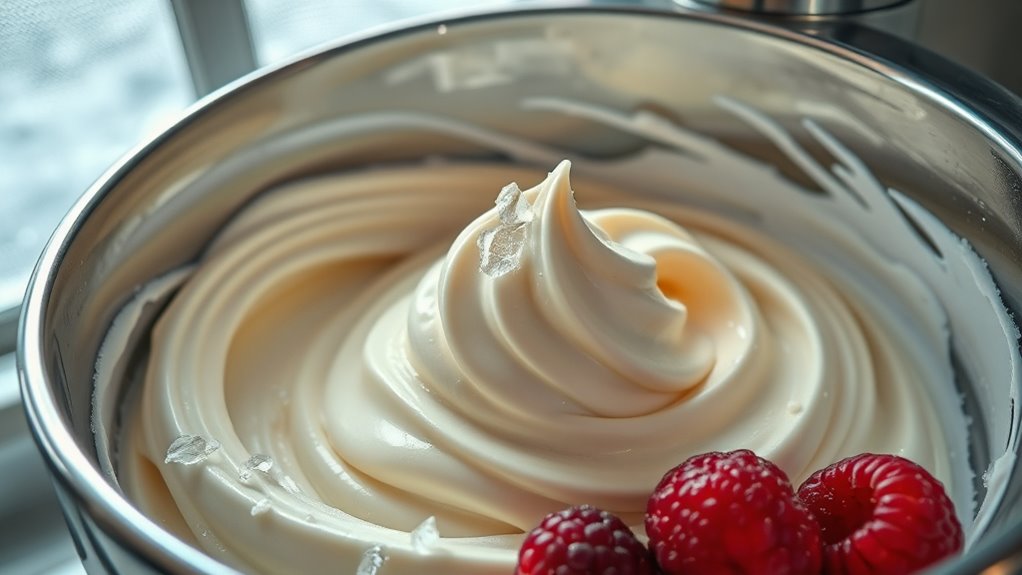
To create the perfect ice cream, mastering the freezing and cooling process is essential.
This process begins with dynamic freezing, where you mix and agitate the ice cream base in a scraped-surface freezer. This incorporates air and forms tiny ice crystals, vital for a smooth texture. Nucleation occurs at the cold walls of the freezer, affecting crystal size—smaller is better. The incorporation of dry ice during the freezing process enhances heat transfer, allowing for rapid cooling of the ice cream base. Additionally, using ingredients with high omega-3 fatty acids can contribute to a richer flavor profile. Proper storage of the ice cream in airtight containers helps maintain its texture and flavor for longer periods. The quality of the butter production process can also influence the creaminess and richness of the ice cream, as high-quality butter can enhance the base’s flavor. Incorporating ingredients with antimicrobial properties can also help preserve the ice cream and prevent spoilage.
Once you reach the static freezing stage, the partially frozen mix hardens in a colder environment, typically around -18°C. Rapid cooling minimizes ice crystal size, enhancing smoothness, while slower rates lead to larger, coarser crystals.
Using cold refrigerants like liquid nitrogen also speeds up cooling, ensuring your ice cream achieves that desirable creamy texture.
The Role of Temperature Control in Ice Cream Making
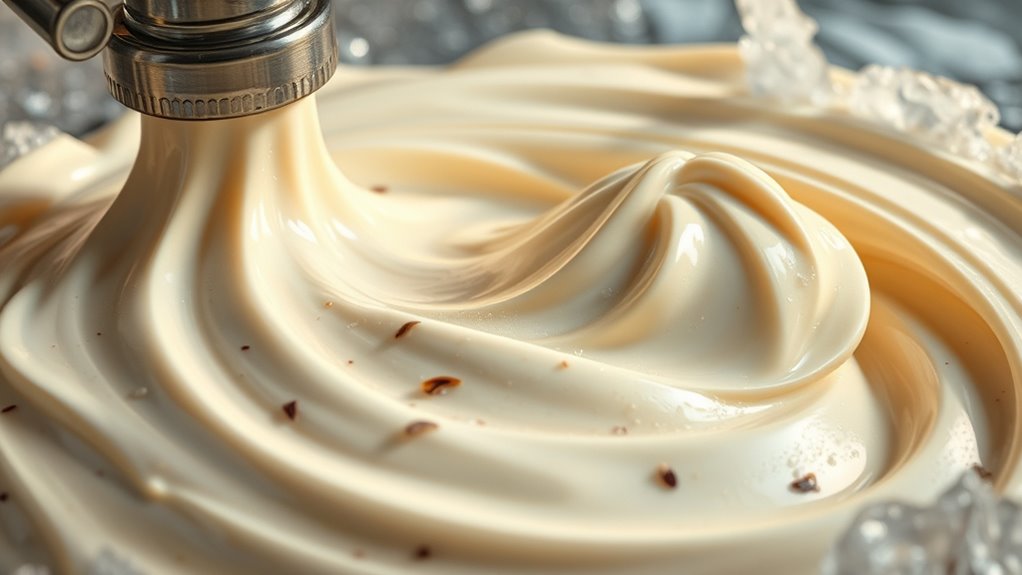
While temperature control might seem like a minor detail, it plays an essential role in ice cream making. Maintaining the right freezing range, typically between -3°C and -6°C, guarantees small ice crystals form, delivering that smooth texture you love. Lower draw temperatures help create these smaller crystals, enhancing your ice cream’s consistency. Using dynamic freezing promotes the formation of small ice crystals, while consistent refrigeration preserves texture during storage. This temperature management also improves melting resistance, keeping your treat solid yet soft even when warm. Plus, proper pasteurization at high temperatures guarantees safety and enhances flavor retention. Additionally, conducting quality control tests during production ensures that the ingredients used contribute to the overall flavor and texture. Furthermore, maintaining optimal air quality in the environment where ice cream is made can also contribute to better flavor profiles. Mammography guidelines are important to consider in health discussions, just as effective temperature control is vital for achieving that perfect scoop of creamy goodness you crave.
Emulsification: Mixing Fat and Water
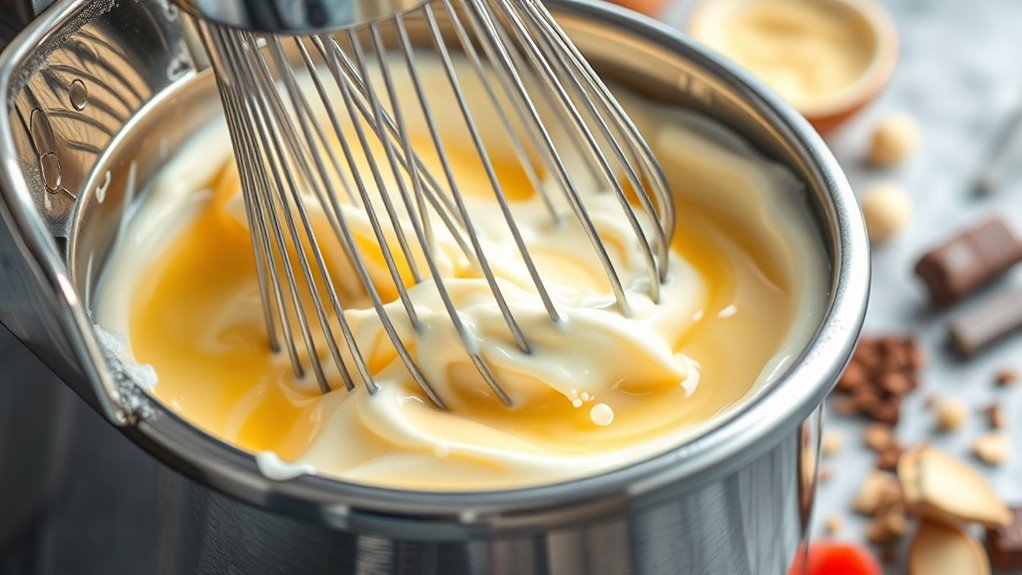
Emulsification is vital in ice cream making because it allows fat and water to mix smoothly, creating that delightful creamy texture you love.
Ice cream is an emulsion, where fat droplets are dispersed in a water-based solution, and emulsifiers like lecithin from egg yolks or soybeans prevent separation. During the process, homogenization breaks up fat droplets into smaller sizes, enhancing stability. Emulsifiers also help incorporate air while churning, making your ice cream lighter and improving texture by preventing large ice crystals. This mixture not only guarantees a consistent flavor distribution but also slows down melting, giving you a satisfying treat that lasts longer. The incorporation of air, which constitutes 30% to 50% of ice cream’s volume, is essential for achieving that light and fluffy texture we all enjoy. Additionally, excessive consumption of ice cream can lead to health issues such as weight gain, highlighting the importance of moderation in enjoying this delicious treat. Furthermore, regular consumption of high-fat ice cream can potentially increase LDL cholesterol levels, emphasizing the need for balance in your diet. Children of unfaithful parents may experience emotional distress, which underscores the importance of stability in family environments.
The Function of Stabilizers in Ice Cream

Stabilizers play an essential role in ice cream, ensuring a smooth and creamy texture that enhances your enjoyment.
These compounds, like guar gum and carob bean gum, control ice crystal growth and improve the mix’s viscosity. By preventing large ice crystals from forming, stabilizers contribute to a smoother mouthfeel, while also reducing water mobility to counteract melting. This is particularly important as control of ice crystal growth manages ripening during hardening and storage.
Stabilizers like guar gum and carob bean gum enhance texture by controlling ice crystal growth, ensuring a smoother mouthfeel and reduced melting.
Higher viscosity mixes, thanks to stabilizers, melt more slowly and maintain their shape. Additionally, they extend shelf life by preventing ice recrystallization during storage.
When used correctly, stabilizers enhance the perception of creaminess and deliver flavors cleanly, making each spoonful of ice cream a delightful experience.
The Pasteurization Process for Safety

To guarantee the safety of ice cream, the pasteurization process is essential in eliminating harmful pathogens and extending shelf life.
You can choose between batch pasteurization, which heats the mix to 69°C (155°F) for 30 minutes, or the faster HTST method, reaching 80°C (175°F) for just 25 seconds. Both techniques effectively destroy pathogens, ensuring your ice cream is safe to consume.
Pasteurization also inactivates spoilage-causing enzymes and reduces bacterial counts to below 100,000 per gram, which enhances quality and flavor. This process is not only crucial for safety but also serves as a legal requirement for ice cream production.
By adhering to regulatory standards through pasteurization, you not only protect consumers but also maintain their trust in your product.
Ultimately, this critical step helps create a delicious and safe ice cream experience.
Techniques for Achieving Creamy Ice Cream

When you’re aiming for that perfect creamy ice cream texture, understanding the right techniques is crucial.
Start with high-fat content ingredients, as they prevent large ice crystals from forming. Sugar plays a fundamental role by binding to water molecules, enhancing smoothness. Incorporate egg yolks for their emulsifying properties, which help blend fat and water seamlessly.
Begin with high-fat ingredients and sugar, then add egg yolks for a smooth, creamy blend.
During churning, introduce air to lighten the texture and reduce ice crystal size. Faster churning at lower temperatures yields a creamier result. Additionally, consider adding up to 3 tablespoons of alcohol to enhance scoopability and further improve the texture.
Consider making a custard base, as it thickens the mixture, adding body. Strain your base to eliminate clumps and chill it overnight for best results before churning.
These steps will guarantee you achieve that desired creamy ice cream consistency.
The Impact of Storage Temperature on Texture
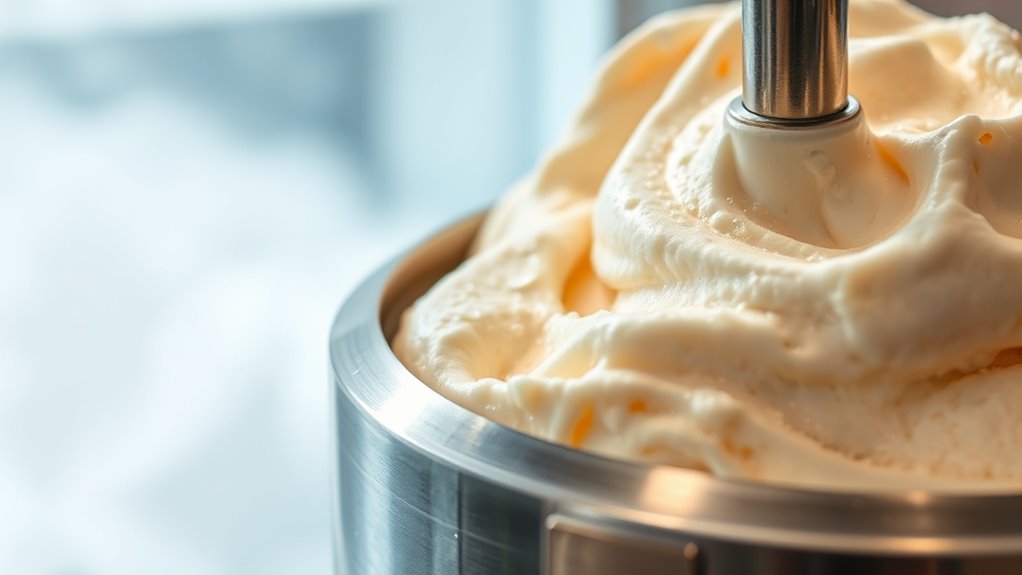
Although you mightn’t realize it, the storage temperature of your ice cream plays a pivotal role in determining its texture. When stored at higher temperatures, ice crystals grow larger, leading to an undesirable icy texture.
The ideal storage temperature is around -28.9°C (-20°F) to maintain that smooth, creamy consistency you love. Lower temperatures, like -50°C, keep ice crystals small, ensuring your treat stays velvety. Additionally, consistent storage prevents air cells from coalescing into larger ones, preserving the light, airy feel. Fluctuations in temperature cause melting and refreezing, resulting in graininess.
To enjoy the best texture, keep your ice cream properly stored and avoid exposing it to temperature changes. Understanding composition is crucial, as it informs the proper balance of ingredients that contributes to the desired mouthfeel. Your taste buds will thank you!
Frequently Asked Questions
Can I Use Alternative Milks for Ice Cream Making?
Absolutely, you can use alternative milks for ice cream making!
Soy, coconut, and cashew milks are great options, each adding unique flavors and textures. Just keep in mind that their lower fat content can affect creaminess.
To improve texture, consider using stabilizers like guar gum. Experiment with blending different milks or adding fats to achieve the desired richness.
With the right techniques, you’ll create delicious, dairy-free ice cream that you’ll love!
How Do Flavorings Affect the Ice Cream Texture?
When you add flavorings to ice cream, they greatly affect its texture. Ingredients like fats, sugars, and emulsifiers change how smooth or creamy your ice cream becomes.
Higher fat content enhances richness, while sugars help lower the freezing point, preventing iciness. Emulsifiers distribute fat evenly, improving mouthfeel.
Using specialty ingredients like fruit or chocolate can also contribute to a more complex and enjoyable texture in your final product.
What Are the Best Tools for Home Ice Cream Making?
Ever dreamt of crafting the perfect scoop? For home ice cream making, you’ll want a few essential tools.
An ice cream machine is vital for churning, while mixing bowls and whisks help blend ingredients smoothly. Don’t forget a digital scale for precise measurements!
For serving, an ice cream spade and classic scoop will guarantee you dish out those creamy delights just right.
With these tools, you’re well on your way to ice cream heaven!
How Long Can Homemade Ice Cream Be Stored Safely?
Homemade ice cream can be safely stored for about 2 to 4 weeks in the freezer if you keep it properly sealed.
However, its texture and flavor start to decline after the first week.
To maximize shelf life, use airtight containers, minimize air exposure, and maintain a consistent freezer temperature.
Placing the ice cream at the back of the freezer can also help maintain its quality for a longer period.
Can I Make Ice Cream Without an Ice Cream Maker?
Why limit yourself to store-bought when you can whip up delicious ice cream at home?
Yes, you can make ice cream without an ice cream maker! Try the two-ingredient method with heavy cream and sweetened condensed milk, or use the plastic bag method for a fun twist.
You can also freeze and stir your mixture or use a food processor for a smooth finish.
Get creative with flavors and enjoy your homemade treat!
Conclusion
In conclusion, understanding the science behind ice cream making can elevate your homemade treats. Did you know that ice cream with smaller ice crystals can be 50% creamier? That’s why churning and controlling temperature are essential. By mastering these techniques, you can create a smoother texture that delights your taste buds. So, next time you whip up a batch, remember the science at play—it’s the secret to achieving that perfect, creamy indulgence you crave!
